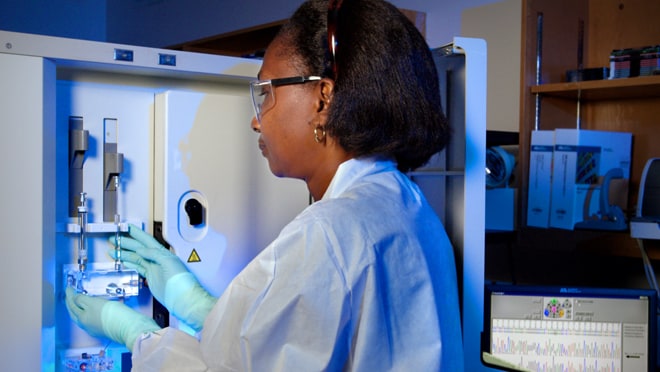At a glance
CDC lab expert Dr. Karidia Diallo has been at the forefront of cutting-edge HIV and TB related laboratory efforts around the world since the beginning of PEPFAR.
It starts with the lab and it ends with the lab

Photo credit: Hsi Liu
In 2003, Karidia Diallo was finishing her Ph.D. in microbiology just as the U.S. President's Emergency Plan for AIDS Relief, or PEPFAR, was starting. Karidia felt lucky – her passion and credentials aligned perfectly with the initiative. In partnership with CDC, PEPFAR was recruiting HIV lab professionals like Karidia to launch an ambitious effort to bring lifesaving treatment to as many people as possible in sub-Saharan Africa – the epicenter of the world's HIV crisis.
"When we started at PEPFAR, we were bringing molecular testing to Africa," she recalls. "People didn't believe that it could happen. They said, you don't have the quality, infrastructure, everything was not there. But we did it!"
Karidia and her colleagues at CDC understood the crucial role of laboratories in the global HIV response, from accurate testing and diagnoses to effective treatment, care and monitoring, and preventing new HIV infections.
They soon leaped into action, partnering with Ministries of Health to train healthcare workers, develop national laboratory strategic plans, improve laboratory quality, and develop innovative diagnostic and monitoring systems. Over the next two decades, CDC's efforts would completely transform the landscape of laboratory systems throughout sub-Saharan Africa.
These laboratory advances been most evident through their impact on HIV testing efforts. Since PEPFAR's inception, CDC has been at the forefront of global efforts to expand and strengthen HIV testing by:
- Increasing access to testing, especially in resource-limited settings.
- Improving testing accuracy and efficiency.
- Expanding capacity.
- Monitoring and evaluating HIV testing services.
CDC's laboratory advances, as part of PEPFAR, have also paved the way for innovative HIV diagnostics and monitoring tools. Innovations include:
- Rapid testing, which can detect HIV antibodies in blood or saliva in less than 30 minutes.
- Index testing, or testing sexual or injectable drug use contacts of individuals diagnosed with HIV.
- Tests for recent infection, which distinguish between recent (within the last one year) and long-term HIV infections.
Collectively, these efforts and innovations are helping to identify more people living with HIV and link them to effective treatment and services in over 50 countries. In 2022, CDC and its partners helped more than 1.4 million people learn their positive HIV test results and start immediately on lifesaving treatment, allowing them to live longer, healthier lives – and interrupting the spread of HIV.
